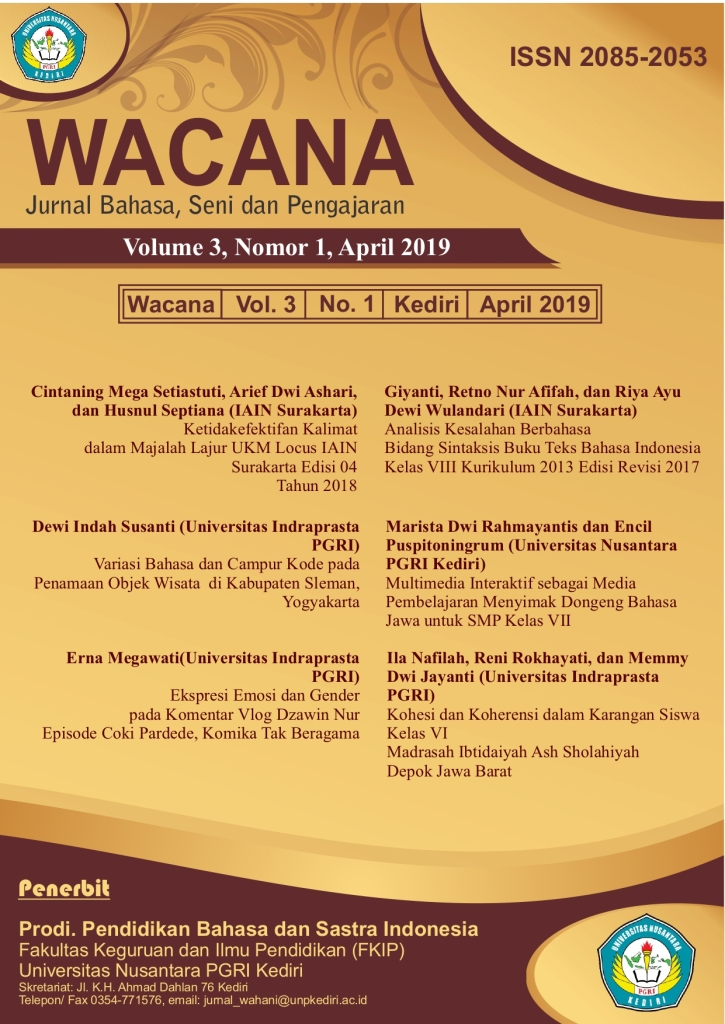Ekspresi Emosi dan Gender pada Komentar Vlog Dzawin Nur Episode Coki Pardede, Komika tak Beragama
Expression of Emotions and Gender in Comments on Dzawin Nur's Vlog Episode featuring Coki Pardede, the Non-religious Comedian
DOI:
https://doi.org/10.29407/jbsp.v3i1.13130Keywords:
bahasa, ekspresi emosi, genderAbstract
Bahasa digunakan manusia untuk mengungkapkan rasa. Berbagai rasa berujud menjadi ekpresi emosi. Emosi tersebut dapat diujudkan secara verbal maupun non-verbal. Penelitian ini merupakan kajian sosiolinguistik dengan fokus bahasa dan gender. Tujuan penelitian ini adalah untuk mengungkapkan penggunaan ekspresi emosi di dalam vlog sebagai media sosial. Ekpresi emosi kemudian diklassifikasikan berdasarkan gender. Metode penelitian yang digunakan adalah kualitatif dengan teknik analisis isi. Hasil temuan menunjukkan bahwa ekspresi marah dan senang adalah ekspresi yang paling banyak digunakan. Dari sisi gender, pria lebih banyak menggunakan ekpresi marah dan senang sedangkan wanita banyak menggunakan ekspresi senang.
References
Al Baqi, S. 2015. Ekspresi Emosi Marah. Buletin Psikologi, 23(1), 22–30. Retrieved from https://journal.ugm.ac.id/buletinpsikologi/article/viewFile/10574/7969
Berg, B. L. 2004. Qualitative Research Methods for The Social Sciences. Pearson.
Biel, J.-I., & Gatica-Perez, D. 2011. Vlog Sense: Conversational behavior and social attention in YouTube. ACM Transactions on Multimedia Computing, Communications, and Applications (TOMM), 7(1), 33. Retrieved from https://infoscience.epfl.ch/record/192342/files/Biel_TOMCCAP_2011.pdf
Eckert, P., & McConnel-Ginet, S. 2003. Language and Gender. Cambridge University Press.
Gay, L.R: Mills, E.G and Airasian, P. 2012. Educational Research: Competencies for Analysis and Applications 9th edition. Pearson.
Hellinger, M., Bubmann, H., Gomard, K., Kunoe, M., & Schafroth, E. 2003. Gender Across Languages. Volume 3.
Hendriks, P. 2014. Asymmetries between Language Production and Comprehension. https://doi.org/10.1007/978-94-007-6901-4
Juliano, S. 2017. Komunikasi dan gender: Perbandingan gaya komunikasi dalam budaya maskulin dan feminim. Jurnal Ilmu Politik dan Komunikasi, 5(01). Retrieved from http://search.unikom.ac.id/index.php/jipsi/article/viewFile/153/155
Jumingan, M. F. Bin. 2002. Penterjemahan Pragmatik dalam Konsep Masa Arab-Melayu: Satu Analisis Teori Relevan. Pertanika Journal Of, 153. Retrieved from http://psasir.upm.edu.my/id/eprint/57704/1/JSSH Vol. 10 %282%29 Sep. 2002 %28View Full Journal%29.pdf#page=68
Kuntjara, E. 2003. Gender, bahasa, dan kekuasaan. BPK Gunung Mulia. Retrieved from http://repository.petra.ac.id/15800/1/Publikasi1_88011_214.docx
Retnowati, S., Widhiarso, W., & Rohmani, K. W. (2003). Peranan keberfungsian keluarga pada pemahaman dan pengungkapan emosi. Jurnal Psikologi, 30(2), 91–104. Retrieved from https://journal.ugm.ac.id/jpsi/article/view/7028/5480
Savitri, E. D. 2018. WACANA EKSPRESI KRITIK SOSIAL MASYARAKAT TERHADAP SINETRON MELALUI MEME INTERNET. IPTEK Journal of Proceedings Series, (5), 13–21. Retrieved from http://www.iptek.its.ac.id/index.php/jps/article/viewFile/4416/3155
Suciati, R. 2014. PERBEDAAN EKSPRESI EMOSI PADA ORANG BATAK, JAWA, MELAYU DAN MINANGKABAU. Universitas Islam Negeri Sultan Sarif Kasim Riau. Retrieved from http://repository.uin-suska.ac.id/5883/3/BAB II.pdf
Sunderland, J., Swann, J., Mils, S., & Caldas, C. (n.d.). Gender Identity and Discourse Analysis. John Benjamins PublishingCompany Amsterdam.
Supriatna, E. 2016. Transformasi Pembelajaran Sejarah Berbasis Religi dan Budaya untuk Menumbuhkan Karakter Siswa. ATIKAN, 2(1).
Suwasana, A. A. 2004. Perspektif Gender dalam Representasi Iklan. Nirmana, 3(2). Retrieved from http://ced.petra.ac.id/index.php/dkv/article/viewFile/16068/16060
Weber, R. . 1990. BASIC CONTENT ANALYSIS. Sage Publications.
Wibowo, P. A. W. 2012. Bahasa dan Gender. LITE, 8(1), 15–23. Retrieved from http://publikasi.dinus.ac.id/index.php/lite/article/download/1105/818













